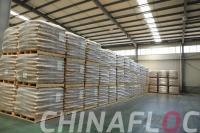anionic polyacrylamide used for red mud setting in alumia processing
Anionic polyacrylamide (APAM) is a type of water-soluble polymer that contains negatively charged functional groups. It is commonly used in various industrial processes, including in the production of alumina (aluminum oxide). Here are some functions of anionic polyacrylamide in the context of alumina production:
-
Settling Aid and Clarification: In the production of alumina, anionic polyacrylamide is often used as a settling aid and clarifying agent. It helps in the separation of suspended solids and impurities from the alumina-containing solution, leading to improved settling characteristics and enhanced clarification.
-
Flocculation: Anionic polyacrylamide promotes flocculation by neutralizing the charges on suspended particles and colloids in the alumina solution. This charge neutralization results in the aggregation of particles into larger flocs, which facilitates their settling and separation from the liquid phase.
-
Improved Filtration: By aiding in flocculation and settling, anionic polyacrylamide can improve the filtration efficiency of the alumina solution. This is particularly important for achieving a clear filtrate and minimizing the content of solids in the final alumina product.
-
Reduced Solid Carryover: Anionic polyacrylamide helps reduce the carryover of solids during various stages of alumina production. This is important for preventing the contamination of downstream processes and ensuring the production of high-quality alumina.
-
Dust Control: In some cases, anionic polyacrylamide may be used for dust control during alumina handling and transportation. By controlling the fine particulate matter, it helps minimize dust emissions and improve overall workplace safety.
-
Improved Settling in Precipitation Processes: In the Bayer process, which is a common method for extracting alumina from bauxite ore, anionic polyacrylamide may be used to enhance settling during precipitation steps. This is crucial for the separation of aluminum hydroxide precipitates from the pregnant liquor.
-
Tailings Treatment: In processes where tailings are generated, anionic polyacrylamide can be applied for tailings treatment. It aids in the flocculation and settling of fine particles, allowing for efficient separation and dewatering of the tailings.
-
Environmental Considerations: The use of anionic polyacrylamide in alumina production may have environmental considerations, and its application should comply with environmental regulations. Careful dosage and monitoring are essential to ensure the responsible use of the polymer.

